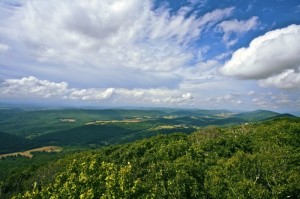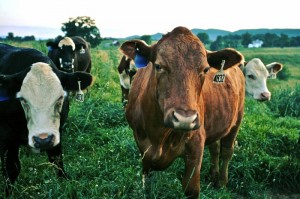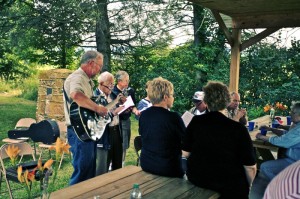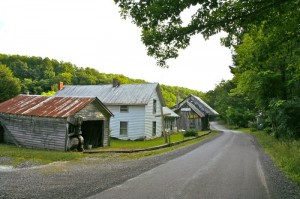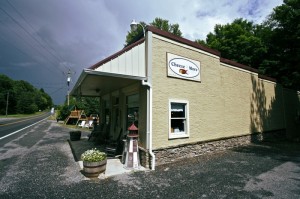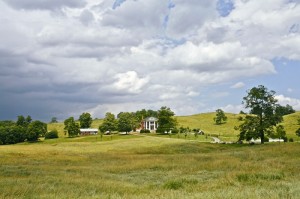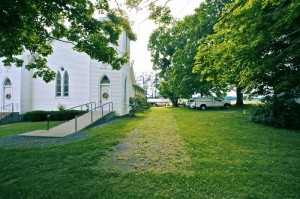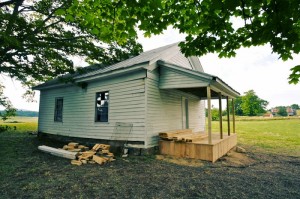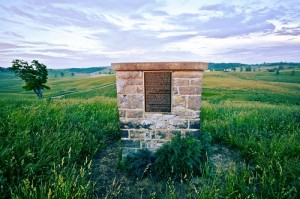
“Monroe County: West Virginia’s Agricultural Heart” by Michael Walker
This article “Monroe County: West Virginia’s Agricultural Heart” was written by Michael Walker for Porter Briggs’, He is the son of Clay and Linda Lemons Walker, who grew up in Monroe County and attended Union High School. Clay (1960), Linda (1964)
Greenbrier County, of which Lewisburg is the county seat, was once a mammoth of a county, stretching over mountains and vales after being formed in 1778 from Botetourt and Montgomery Counties of Virginia, counties themselves that were quite massive. In 1799, however, the lower portion of Greenbrier County was cleft off to form a new county, Monroe, in response to the inability to govern so large a land area from Lewisburg alone—and the time required by horse to reach Lewisburg from the far reaches of what would become Monroe County.
Even today Greenbrier County ranks as one of the largest of West Virginia’s counties in land area, and much of that land is not only rural but rustic with rugged mountains and woodlands that have hardly changed since the 1800’s. Monroe is much the same way, but with an economy even more related to agriculture than that of Greenbrier and a wealth of human and natural history of its own. Monroe often has been somewhat in the shadow of Greenbrier County, which became famous with the Greenbrier Resort, the tourism draw of Lewisburg, and the fact that the state fairgrounds are located in Greenbrier County—but even the fair is a testament as much to Monroe County’s agricultural contributions since it has forever been tied to farming while most parts of the state have been known for coal and timber production.
Monroe County in many ways retains the heritage of the pioneer, mountainous South that is quickly disappearing elsewhere and that has been slowly dissolving since at least the 1950’s. Part of this retention is geographical: Monroe is not crossed by any interstate highways, features no public-use airports, and has very limited railroad incursion, with rails coming into Alderson, a city on the county line with Greenbrier County, but not the criss-cross of train-tracks we find in much of the Mountain State. Its county seat of Union is a sleepy little town that hasn’t changed much over my entire lifetime. Farming is still a primary profession for many folks, and other residents who may work as school-teachers, police, or in other careers also may keep some cattle or otherwise engage in farming on the side. My cousin, Hazel Shrader, was one such person who throughout her long career as a teacher kept livestock on the small farm she inherited from her parents. Having never married, she tended her cattle on her own, getting up before dawn in the harsh winter months to ensure they had feed and water for the day before leaving for the schoolhouse. That type of dedication was not—and still is not—uncommon in Monroe County.
The role of agriculture in Monroe is seen most clearly in the county’s very own holiday, Farmers’ Day, held every June, where local agriculture is celebrated with parades, rodeos, dances, and other events. The State Fair in Greenbrier County is also a big event locally, and many children grow up involved in 4-H, Future Farmers of America, and other groups and show livestock or crops at the fair. Drive into the county seat of Union nearly any day and you’ll see cattle trailers or a tractor on a flatbed truck—or perhaps even a tractor just driving down the street. Most farms here are family-owned, and beef cattle are by far the leading livestock output, though dairy farms also exist, and sheep seem to be making a comeback: as recently as the 1960’s, sheep and hogs were important to the local economy, but from the 1980’s onward cattle became the main focus. The geography is suited to cattle or sheep, with rolling hills, abundant creeks and springs, and fine pastures but not enough rich-soiled flatlands to make for successful growing of commercial field-crops, though most farmers do plant hay and corn (for silage) to tide their own cattle over the winter months or to sell to other farmers.
US Highway 219 cuts through the center of Monroe County, joining Peterstown on the southern side of the county to Union and continuing on to Greenbrier County where it eventually reaches Lewisburg after passing through Ronceverte and Fairlea plus much of the countryside. It is, at least as local roads go, less-winding and fairly easy to navigate, and it runs by much of the most-beautiful of the local farms, with the state’s famed mountains in the background. In contrast, other parts of the county are fairly difficult to access: with a hardy truck, or in good weather even a two-wheel drive vehicle, it’s possible, but there is a romantic feeling of going back in time and trekking to a place seldom seen.
Small communities such as Glace, Pedro, and Zenith lay within vales between impressive, tree-covered mountains. Though this landscape is lovely, indeed at times nearly overwhelming with its natural beauty, it is also challenging in a hardscrabble sense and would have been more so for our forefathers who through hard work crafted out humble livings in places hard to reach and prone to heavy snowfall in the winter and flash flooding in the spring.
Glace gained its name for the frost and snow covering the fields noted by early settlers. Zenith today is basically a cluster of homes, but buildings remain which were once a gas station, a general store, and a volunteer fire brigade, probably in service up through the late 1980’s. Such material culture speaks of the need for very localized services, a store you could walk over to and firemen who could respond quickly. It speaks to a pleasant sense of close community but also to isolation. Before everyone had a car, what constituted a community was quite different from what we may consider one now—it wasn’t a small town with two banks and three churches, but a grouping of homes and possibly a small store, a single church, or a one-room schoolhouse.
There is an old fire tower at a site called Hanging Rock to the west of Zenith, now under the control of the US Forest Service and on the Allegheny Trail, where one can hike a short trail and take in a breathtaking view of much of the county from a perfect mountain perch. The tower is used by scientists to count native raptor species in the fall but also is popular for just gazing at the beautiful countryside, even when the birds of prey are not out flying.
Driving up the narrow and winding road to Hanging Rock you pass many small farms, and if you take that road in the opposite direction and head towards Gap Mills, you’ll come to the Cheese N More store and the Kitchen Creek Bakery, two businesses run by a group of local Mennonites. The Cheese N More sells, in addition to cheeses, an ample selection of bulk dry goods, stone-ground cornmeal, and other natural and old-timey foodstuffs including delicious fudge. If their selection of sweets isn’t enough for you, though, the neighboring Kitchen Creek Bakery makes old-fashioned pies as well as breads and other baked goods—their pies are really the stand-out items, especially those like their butterscotch pie that use time-tested recipes and were once regional staples but are now seldom seen unless made at home. Yoder’s brand of jams and jellies, also made by Mennonites locally, are found for sale across the state but given a place of pride in the Cheese N More Store.
Though not as developed for tourism as Greenbrier County, the abundance of pristine natural beauty in Monroe County, slower pace of life, and the fact that Lewisburg is only a short drive away has started to draw in some tourism. A nice aspect of this is that there are not really “touristy” places yet but places that are frequented by locals and visitors alike. One such business and a mainstay of Union is the Korner Kafé, a restaurant known for its friendly, folksy atmosphere, historic building, and Betty Lemons’ superb home-cooking. Two other restaurants, Nanny’s and the Hall Tavern, recently opened in restored historic homes, and there is an inn in town and another bed and breakfast in the lower part of the county towards Peterstown. Moncove Lake State Park, just outside of Union between it and Gap Mills, is a favorite attraction as well as is nearby Old Rehoboth Church, an early Methodist church in a log construction building and the oldest extant church in the state, now a museum.
Union’s stately churches as well as others such as Trinity United Methodist of nearby Pickaway also add character to the community and have long been a pivotal center of society in this close-knit county. Trinity Methodist is also the site of the first Corn Club in West Virginia (established in 1908), and the original one-room schoolhouse building where that Corn Club met is being restored for the sake of history. Corn Clubs were forerunners of 4-H in the South and around the turn of the century were efforts to educate rural children about new, scientific methods in agriculture. The concept was that by teaching these methods to children, the kids would become more interested in farming, feel like stakeholders in their efforts, and also communicate new developments to their parents who might be too busy or just not receptive to learning such themselves. Corn Clubs were a basal formation for not only 4-H but youth social groups in general in rural farming regions.
Though somewhat off the beaten path, Monroe County still holds the charms and surprises of the “real” West Virginia unspoiled by time or vast change, and you’ll never know what you might encounter—anything from a gospel sing to a bear while driving down the road to Alderson.
By: Michael Walker
Photos by Michael Walker-Story printed with permission from Michael Walker.


